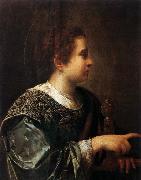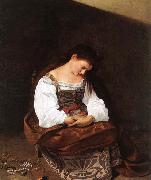Wholesale Oil Painting No Minimum |
|||||||||||
|
|
|||||||||||

|
|||||||||||
|
|
|
||||||||
Carlo Dolci1616-1686 Italian Carlo Dolci Locations Italian painter. The major Florentine painter of the 17th century, he enjoyed an international reputation in his own lifetime. He was a gifted portrait painter and painted a number of large altarpieces, but his reputation is largely based on his half-length, single-figure paintings, characterized by their intense religiosity and meticulous technique. His mature style was complex and sophisticated. Intended for cultivated and aristocratic circles, his was never a popular art in any sense. Baldinucci described the painter tormented fantasy and dark fantasms, and his disturbed personality is evident throughout his work after the later 1640s. |
||||||||
|
|
||||||||
Magdalene
Magdalene Painting ID:: 981 |
1660-70
Galleria degli Uffizi, Florence 1660-70 Galleria degli Uffizi, Florence |
|||||||
|
|
||||||||
VOUET, SimonFrench Baroque Era Painter, 1590-1649 French painter and draughtsman. Although at the time regarded as one of the leading French painters of the first half of the 17th century, he is now known more for his influence on French painting than for his actual oeuvre. He made his reputation in Italy, where he executed numerous portraits for aristocratic patrons and was commissioned for religious subjects. Although the early Italian works show the influence of Caravaggio, his work was subsequently modified by the Baroque style of such painters as Lanfranco and the influence of the Venetian use of light and colour. When he was summoned back to France by Louis XIII in 1627 he thus brought with him an Italian idiom hitherto unknown in France that revitalized French painting |
||||||||
|
|
||||||||
|
|
Magdalene
Magdalene Painting ID:: 51186 |
1614-15
Oil on panel,
63 x 49 cm 1614-15 Oil on panel, 63 x 49 cm |
||||||
|
|
||||||||
CaravaggioItalian Baroque Era Painter, ca.1571-1610 Italian painter. After an early career as a painter of portraits, still-life and genre scenes he became the most persuasive religious painter of his time. His bold, naturalistic style, which emphasized the common humanity of the apostles and martyrs, flattered the aspirations of the Counter-Reformation Church, while his vivid chiaroscuro enhanced both three-dimensionality and drama, as well as evoking the mystery of the faith. He followed a militantly realist agenda, rejecting both Mannerism and the classicizing naturalism of his main rival, Annibale Carracci. In the first 30 years of the 17th century his naturalistic ambitions and revolutionary artistic procedures attracted a large following from all over Europe. |
||||||||
|
|
||||||||
|
|
Magdalene
Magdalene Painting ID:: 62386 |
122,5 x 98,5 cm Galleria Doria-Pamphili, Rome This picture and The Rest on the Flight into Egypt must have been painted around the same time, for the same girl sat for the Magdalene and the Madonna. On this occasion, however, there are none of the usual signs of a religious scene such as a halo. A young girl, seen from above, is seated on a low stool in one of Caravaggio's favourite cave-like settings, with a triangle of light high up on the wall behind her. Discarded jewellery - a string of pearls, clasps, a jar (perhaps holding precious ointment) - lies on the floor. The girl's hair is loose, as if it has just been washed. Her costume, consisting of a white-sleeved blouse, a yellow tunic and a flowery skirt, is rich. Bellori, who gives a careful description of this picture, which he came across in the collection of Prince Pamphilj, regards its title as an excuse; for him it is just a naturalistic portrayal of a pretty girl. This seems to show a willful failure to understand Caravaggio's intention or the wishes of the man who commissioned it, Monsignor Petrignani. The repentant Mary Magdalene, like the repentant Peter, was a favourite subject of Counter-Reformation art and poetry, which valued the visible expression of the state of contrition 'the gift of tears'. Caravaggio's heroine is sobbing silently to herself and a single tear falls down her cheek. She is, as it were, poised between her past life of luxury and the simple life she will embrace as one of Christ's most faithful followers. It is a sign of the painter's skill that he makes this inner conflict moving at the same time as he makes its representation delectable. Although nothing painted in the sixteenth century is as emotive as the statue in wood of the haggard saint carved by Donatello (c.1456-60), by the time Titian's bare-breasted Magdalene of the 1530s (Palazzo Pitti, Florence) had become the more modest and affecting Magdalene of the 1560s, there had been a move in religious sensibility towards the humble and pathetic, a change which thirty years later Caravaggio could take for granted 122,5 x 98,5 cm Galleria Doria-Pamphili, Rome This picture and The Rest on the Flight into Egypt must have been painted around the same time, for the same girl sat for the Magdalene and the Madonna. On this occasion, however, there are none of the usual signs of a religious scene such as a halo. A young girl, seen from above, is seated on a low stool in one of Caravaggio's favourite cave-like settings, with a triangle of light high up on the wall behind her. Discarded jewellery - a string of pearls, clasps, a jar (perhaps holding precious ointment) - lies on the floor. The girl's hair is loose, as if it has just been washed. Her costume, consisting of a white-sleeved blouse, a yellow tunic and a flowery skirt, is rich. Bellori, who gives a careful description of this picture, which he came across in the collection of Prince Pamphilj, regards its title as an excuse; for him it is just a naturalistic portrayal of a pretty girl. This seems to show a willful failure to understand Caravaggio's intention or the wishes of the man who commissioned it, Monsignor Petrignani. The repentant Mary Magdalene, like the repentant Peter, was a favourite subject of Counter-Reformation art and poetry, which valued the visible expression of the state of contrition 'the gift of tears'. Caravaggio's heroine is sobbing silently to herself and a single tear falls down her cheek. She is, as it were, poised between her past life of luxury and the simple life she will embrace as one of Christ's most faithful followers. It is a sign of the painter's skill that he makes this inner conflict moving at the same time as he makes its representation delectable. Although nothing painted in the sixteenth century is as emotive as the statue in wood of the haggard saint carved by Donatello (c.1456-60), by the time Titian's bare-breasted Magdalene of the 1530s (Palazzo Pitti, Florence) had become the more modest and affecting Magdalene of the 1560s, there had been a move in religious sensibility towards the humble and pathetic, a change which thirty years later Caravaggio could take for granted |
||||||
|
|
||||||||
|
Caravaggio Italian Baroque Era Painter, ca.1571-1610 Italian painter. After an early career as a painter of portraits, still-life and genre scenes he became the most persuasive religious painter of his time. His bold, naturalistic style, which emphasized the common humanity of the apostles and martyrs, flattered the aspirations of the Counter-Reformation Church, while his vivid chiaroscuro enhanced both three-dimensionality and drama, as well as evoking the mystery of the faith. He followed a militantly realist agenda, rejecting both Mannerism and the classicizing naturalism of his main rival, Annibale Carracci. In the first 30 years of the 17th century his naturalistic ambitions and revolutionary artistic procedures attracted a large following from all over Europe. Magdalene 122,5 x 98,5 cm Galleria Doria-Pamphili, Rome This picture and The Rest on the Flight into Egypt must have been painted around the same time, for the same girl sat for the Magdalene and the Madonna. On this occasion, however, there are none of the usual signs of a religious scene such as a halo. A young girl, seen from above, is seated on a low stool in one of Caravaggio's favourite cave-like settings, with a triangle of light high up on the wall behind her. Discarded jewellery - a string of pearls, clasps, a jar (perhaps holding precious ointment) - lies on the floor. The girl's hair is loose, as if it has just been washed. Her costume, consisting of a white-sleeved blouse, a yellow tunic and a flowery skirt, is rich. Bellori, who gives a careful description of this picture, which he came across in the collection of Prince Pamphilj, regards its title as an excuse; for him it is just a naturalistic portrayal of a pretty girl. This seems to show a willful failure to understand Caravaggio's intention or the wishes of the man who commissioned it, Monsignor Petrignani. The repentant Mary Magdalene, like the repentant Peter, was a favourite subject of Counter-Reformation art and poetry, which valued the visible expression of the state of contrition 'the gift of tears'. Caravaggio's heroine is sobbing silently to herself and a single tear falls down her cheek. She is, as it were, poised between her past life of luxury and the simple life she will embrace as one of Christ's most faithful followers. It is a sign of the painter's skill that he makes this inner conflict moving at the same time as he makes its representation delectable. Although nothing painted in the sixteenth century is as emotive as the statue in wood of the haggard saint carved by Donatello (c.1456-60), by the time Titian's bare-breasted Magdalene of the 1530s (Palazzo Pitti, Florence) had become the more modest and affecting Magdalene of the 1560s, there had been a move in religious sensibility towards the humble and pathetic, a change which thirty years later Caravaggio could take for granted |
||||||||
|
|
||||||||
|
Prev Next
|
||||||||
|
|
||||||||
|
Related Paintings to Caravaggio :. |
||||||||
|
|
||||||||
|
CONTACT US |



